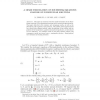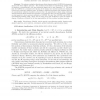184 search results - page 4 / 37 » An optimal adaptive mixed finite element method |
SYMMETRY
2010
13 years 2 months ago
2010
: The theory of elasticity is used to predict the response of a material body subject to applied forces. In the linear theory, where the displacement is small, the stress tensor wh...
MOC
2000
13 years 7 months ago
2000
Abstract. This paper is concerned with the mixed formulation of the Boussinesq equations in two-dimensional domains and its numerical approximation. The paper deals first with exis...
Publication
In this paper we apply the ideas of algebraic topology to the analysis of the finite volume and finite element methods, illuminating the similarity between the discretization str...
SIAMNUM
2010
13 years 2 months ago
2010
We analyze an adaptive discontinuous finite element method (ADFEM) for symmetric second order linear elliptic operators. The method is formulated on nonconforming meshes made of si...
MOC
2002
13 years 7 months ago
2002
Averaging techniques are popular tools in adaptive finite element methods since they provide efficient a posteriori error estimates by a simple postprocessing. In the second paper ...



